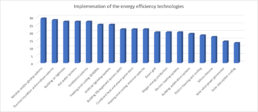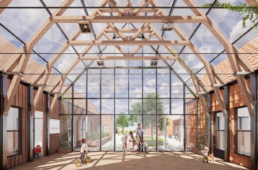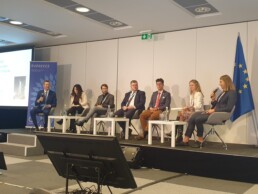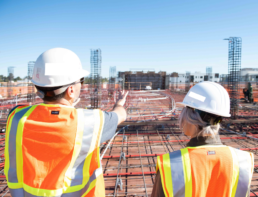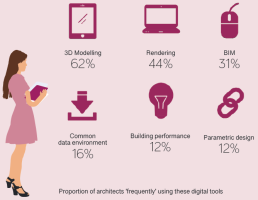Women in construction: gender stereotypes and education initiatives
The construction industry is historically a predominantly male sector and it still is today, despite the evolution of techniques, and the progress in innovation and safety. Although there is a slight trend of more women getting involved, there are still very few of them who choose this field worldwide. The same we can argue about younger tech savvy generations. Yet, this sector offers a great variety of careers and great opportunities for everyone.
Thanks to the development of ever-new technologies and an increase of digitalisation as well as an inclination towards more environmentally sustainable practices, the construction industry today offers a variety of positions perfectly within the reach of men and women equally.
There is the need to break stereotypes that still persist today and demotivate younger people and women from taking an interest in careers in this sector. A part of the solution could involve implementing education practices that would be informative and stimulating to a younger audience, including women and men equally.

Where do stereotypes come from?
According to a series of surveys conducted in the Southern part of Italy in 2024, in this region stereotypes around the construction sector often concern exploitation and safety, bad hygiene and practical disorganisation of construction sites.
Among other popular concerns, there is the existence of many micro family construction businesses that offer little flexibility to workers. Other doubts concern career possibilities, given that this sector is still seen today as a 'makeshift' choice of profession compared to other ‘more stable’ ones, and with less possibility of future career shifts and fewer contractual protections.
Predominantly female preoccupations involve the fear of absence of contractual concessions, for instance, in case of maternity leaves, and the incompatibility with a family life schedule.
Another stereotype, is about the idea that work in the sector is only physical and therefore tiring and only suitable for men. The sector offers a wide range of physical
and non-physical occupations, within everyone's reach.
Finally, important concerns are linked to poor remuneration and an unstable economic future.
The existence of preconceptions are above all attributable to the lack of adequate and sufficient guidance in schools and advice for young graduates.
Even if the surveys concerned Italy, many of them could be translated in other regions, and are worth serious consideration all over Europe.
Some of these reported issues await serious interventions from businesses and the establishment of better local policies. In certain instances, we could easily arrive at solutions that would result in more interest from women but also from younger people, who are very sensitive to the problems of risk, lack of opportunities and low pay.
Orientation programs and initiatives in the education system
With the hope that construction site work will soon become more accessible to everyone, it is important to dissipate false believes, starting from childhood. In fact, we could try to reduce the differentiation between "male" or "female" toys and games and in general present the variety of possible future professions in a more neutral and objective way, considering technological and social innovations.
The bodies that deal with training (schools, training centers and specialized companies) should first of all strengthen relationships with companies in the sector that place employee training and innovation in the construction professions first.
A clear presentation of the variety of different opportunities regarding construction careers is necessary, even directly by young people and women already working in the field, to dispel the false belief of a "hard and dirty" profession.
It is important to give visibility to the concept that construction is not limited to manual work but it also offers a large scale of intellectual and creative activities. This is also thanks to the development of ever new technologies, which with the contribution of new professionals will continue to develop exponentially in every branch of the field.
We should promote and encourage the use, right from school, of software and programs dedicated to new professions. Today it is possible to download free software that allow, for example, to easily reproduce an apartment digitally and which is already within everyone's reach, including boys and girls in their first educational cycle.

By taking advantage of what digital technology already offers today, stimulating school initiatives could be promoted such as training workshops that invite sharing and group planning, to promote the development of new ideas in collaboration with one's classmates.
An example of digital application to the construction industry is BIM, a system based on sharing and co-design that the current system of education would not put among its primary objectives. Most educational processes nowadays are in fact designed to be carried out "autonomously", while in the construction world everything is interconnected. The architectural project cannot, in fact, ignore the structural or plant requirements, nor the impact that each of these choices has on the environment directly or indirectly, or the needs of the end users.
Professional training should include internships with professional studios and/or construction companies that already exploit digital technologies and therefore with direct experience in the field.
It is also essential to clearly present the general development of skills offered by jobs in construction through a presentation at 360° of the sector.
New uses of technologies and schools initiatives
Health and safety at work should represent a pre-requisite to any other training course and the use of artificial intelligence for safety on construction sites should also become a learning requirement. AI is, for example, capable to detect anomalies in daily activities on the construction sites and therefore avoid unnecessary risks. Through constant monitoring via cameras and sensors, AI is able to identify unusual or non-compliant behavior with safety procedures and to recognize potentially dangerous situations, such as, for instance, the presence of risky substances not managed correctly.
Another example of an innovative use of digitalisation is that of the use of "smart glasses", devices which, once installed on the helmet connected to specific software, allow you to compile check lists through voice commands, but also take photos and record automatically. Elements which therefore make the inspection of the construction site more precise. Furthermore, the collaborative platform can put workers in communication with the office, to remotely obtain information on how to proceed or even the documentation to allow implementation in compliance with the project.
Knowledge of these cutting-edge technologies could also be acquired by inviting young people to participate to "building fairs" and to experience them directly in workplaces and ongoing and completed construction sites. This would allow being able to listen to the direct testimonies of designers and builders.

In the image above, a company specializing in acrobatic restoration gave the opportunity to boys and girls to experience the feeling, thanks to augmented reality glasses, of being harnessed at an altitude.
In the images below, the Formedil school of Udine brought the students of the school to the restoration fair in Ferrara, demonstrating the creation of artistic work, certainly suitable for both genres.



Another suggestion is to organise more public events such as, for example, the "career days" at high schools and universities.
It is essential to also socially and intellectually valorise the more artisanal professions, breaking the stigma of not sophisticated and poorly paid jobs. These professions can, on the contrary, offer interesting opportunities and particularly creative and original activities.
Towards a younger and more inclusive construction industry
In conclusion, to promote more participation of women and young people in the work in the construction industry, it is necessary to address some problems still present today, such as stereotypes linked to the industry, safety, poor working conditions and the possibility of successful careers. It is also fundamental to facilitate the possibility for women and young people to learn about all professional paths and possibilities present within the construction industry. These professional choices can in fact prove very satisfying for them and beneficial for the industry. This campaign should also be realised through school initiatives and the organisation of events and fairs that promote careers in the supply chain. Finally, it is essential to support and motivate women during their career path, so that they become examples and inspirations for the next generations.

Reaching a Sustainable Built Environment: Our Analysis
We just published the Report: “European roadmap: BIM applied to energy performance”.
The report provides inputs to develop a roadmap to achieve the correct development of a workforce ready to face the challenges of climate changes. The report starts recalling the requirements already defined in the European directives dealing with energy performance, the use of renewable energy sources, and digitalisation. Then, starting from the outputs of the previous deliverables, the roadmap summarises the knowledge, the skills and the competences needed both on the demand side and the offer side to obtain more resilient buildings to climate change with a decreased use of natural resources.
The roadmaps intend to ensure that current and future stakeholders interested in increasing the competences in the energy and digital domains, guarantee that existing and future training materials are adequate and continuously adapt to change. The roadmaps start from an in-depth analysis of the status quo in the participating countries.
The roadmaps should allow any company, public administration, and individual to fill the gap of competences and take advantages of all innovative energy and digital technologies.
In all the partner countries there is legislation supporting both the use of renewable energy sources and the improvement of the energy performance. Digitalisation is not always compulsory, but there are many initiatives to increase the competences in this domain starting from the public tenders where the use of BIM is becoming required in many countries. Consequently, we expect a huge future increase in the demand of digital competences needed in all the supply chain.
To provide the basis for the development of national roadmaps we considered a matrix where we suggest the level of knowledge/competence of the different targets for each technology. Digitalisation should be considered an instrument and not a final goal and should be applied by any blue and white collar of the building supply chain during its whole life cycle.
The goals of the directive are the same in every country. However, some countries are a few steps ahead in its implementation. To ensure the achievement of the same level by all, it is essential to promote the implementation of new technologies on both the demand and the offer side.
Based on a survey circulated among the project partners, we can make some interesting assumptions.
There is a strong correlation between the quality of the national VET (Vocational, Educational and Training) and LLL (Life-Long-Learning) systems and the use of technologies related to energy performance in buildings. North European countries developed more reliable training systems, and as a consequence they also make a better use of RES and technologies for energy efficiency. There is a persistent need, in all countries, to facilitate the use of more innovative technologies, which are still rarely taught in formal training.
In the following two diagrams we can observe the level of implementation of the different technologies considering the average of the different countries.
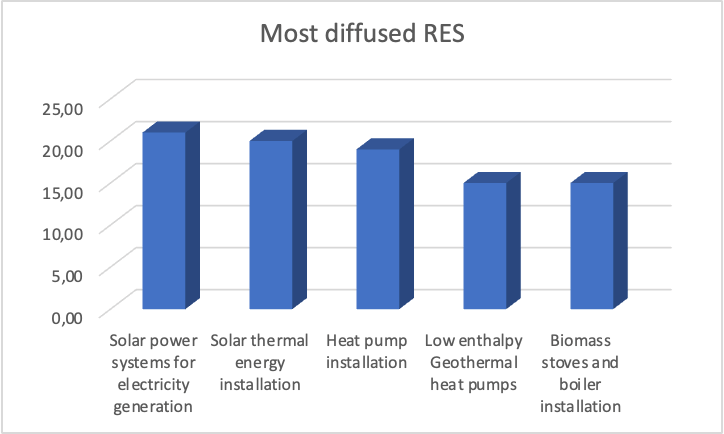

The ARISE platform can provide the support needed to achieve a higher maturity level in any sector and for any target as it is based on micro-competences. Thanks to the platform, the new technologies can be introduced directly by their producers. They can use it as a mean to provide training materials to be able to design, install and maintain new equipment and/or materials that can improve the energy performance of buildings.
The implementation of digitalisation shows that the problem is more related to the lack of a full maturity on the demand side. Designers are usually ready to implement digitalisation as it facilitates their work, but if the demand of public administration and both public and private owners does not increase, it cannot be fully implemented in the supply chain. The consequence is that the owners cannot profit from the benefit of managing all the information linked to their assets in order to decrease the cost of management and maintenance.
In the following diagram we can observe the different levels of maturity as average of the situation in each of the partners’ countries.

If the constructors do not implement the model received by the designers with the information of the products and equipment used and installed, the owner gets only marginal benefit from the BIM model produced by the designer. Therefore, there is a strong need to increase the comprehension of the benefits introduced by the full implementation of BIM in the supply chain. This analysis is also useful for training program developers and providers, providing them with directions on how to profile their programs.
In this case too, the ARISE platform can be beneficial as the European chapters of buildingSMART international are working for an agreement aimed at increasing awareness of the benefits of BIM along all the supply chain using the training materials developed for the individual qualifications available for free to everyone.
For more information, download the Report here.
How are climate change, the construction industry and BIM connected?
It is common knowledge now that the construction industry is one of the major culprits of the ecological footprint. The cement industry alone is in third place for the production of CO2 after the countries of China and the USA. Time is running out, and all designers in the sector need to begin to work collaboratively to the transition towards more sustainable paths.
However, designing zero energy buildings is not enough. We must also reduce the use of materials that pollute excessively and the overly exploitation of natural resources. We need to put in place plans for reusing and recycling, and the materials to recycle should come also from waste, and not only from the demolition of buildings.

In Copenhagen, during the conference organized on December 7th by KEA (Copenhagen School of Design & Technology), it was underlined the importance of architects and engineers considering the use of appropriate materials already in the preliminary design phase. Also important is limiting the use of reinforced concrete to those buildings and structures that really need it and, wherever possible, considering alternative solutions that can be even more performing. It is also necessary to reuse the material resulting from demolitions in a smart way.
In France and Denmark, in application of the European recommendations for the reduction of the ecological footprint, the law requires the declaration of the total of CO2 produced. Not only as LCA, i.e. a simple certification of how much CO2 that particular building produces, but it is also required to justify the choice on the materials, which must produce less CO2 than alternative solutions.
During the debate following the conference it was rightly pointed out that "virgin" materials often have a lower cost than the recycled ones because the production process from raw materials is simpler than the recycling of existing materials, especially if their composition is unknown. Soon however, to encourage recycling, in Denmark it will be introduced a tax on the production of CO2, which will make the price of the two choices comparable and will possibly make recycled materials more advantageous.
In Denmark, they initiated pilot cases in which, for example, it was approved the project of a nursery school in place of an old abandoned school, provided that the materials derive from the demolition of the old structure. In place of the old school there are now two soccer fields and a nursery school built sustainably and on a zero impact criteria. This thanks to the saving of "virgin" material which normally requires a large energy contribution, both in production and for transportation. Furthermore, wood has once again become the first choice, both for new houses and for renovations.
The role and contribution of BIM in all of this was also discussed. A software was shown that BIM allows to evaluate the CO2 footprint, just as there are already 4D and 5D software that allow to evaluate times and costs. Each product is connected with its ecological footprint, i.e. with the carbon dioxide produced for its production. In this way, it is possible for the designer to attribute a real value to the ecological footprint of the entire building.
It is clear that the role of material producers is becoming more and more Impactful. They must transition from providing the values that certify the "ecological footprint" in simple pdfs, to the transmission of data that can be directly read by design software. To allow this, the bSDD is already available, i.e. a service that buildingSMART International makes available to "translate" any property and geometry into data that can be read by modeling software.
Essentially, it is enough to connect these properties and values to each element. As an example, the "wall" properties can be linked to reinforced concrete, solid bricks, hollow bricks, laminated wood, recycled panels and so on to which the manufacturer will have to associate the corresponding "CO2/metre" properties. The software, at that point, can directly calculate the final footprint.

By changing the material, in a few clicks, the final value can automatically be updated. This will facilitate the final selection.
However, there is still a long way to go. For example, we need to work on new legislative instruments that support this approach. In public tenders, it will be necessary that the ecological footprint has a weight in the selection, so that designers are encouraged to make more ecological choices. It will also be important to help small producers of recycled materials to certify their products with the CE mark in order to be able to place them in the market. It will also be necessary to properly train manufacturers and the workforce to use these new products correctly. Finally, it will be necessary to support research in this sector.
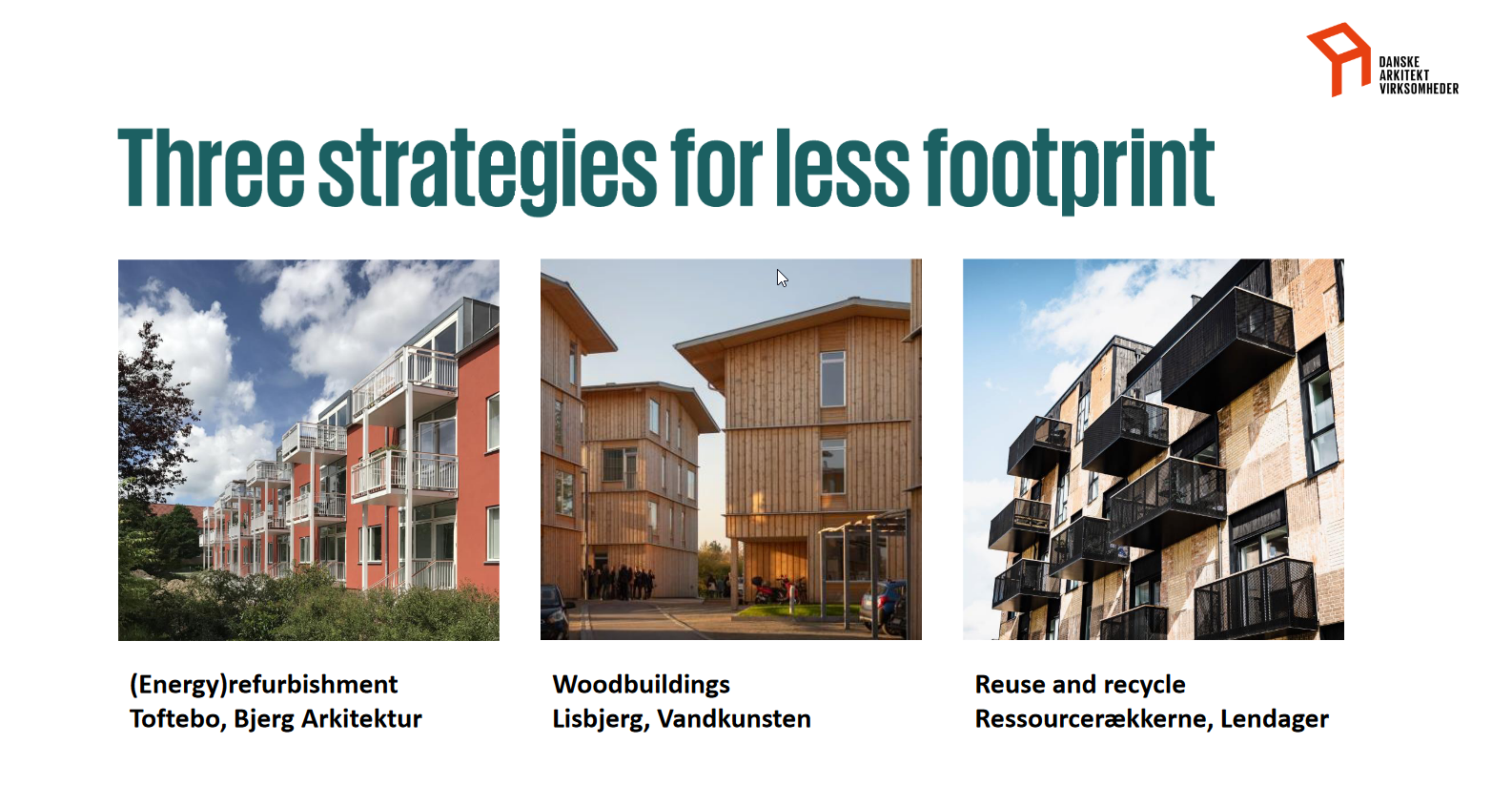
These topics will also be addressed during the next buildingSMART International Summit, which will be held in Rome from 27 to 30 March 2023.
All the European chapters of buildingSMART will also meet, on this occasion, with the European Commission (DG Growth) to look for agreements to ensure that part of the substantial funding foreseen for the construction sector will be directed to these activities. We invite you to participate numerous at the Summit, that is open to all interested parties in the sector, members and non-members of buildingSMART.
Presentation and images by Lene Espersen
Article by Anna Moreno and Caterina Nissim
Digital Construction Conference 2022 – Towards Construction 4.0 and the future of this sector in the digital era
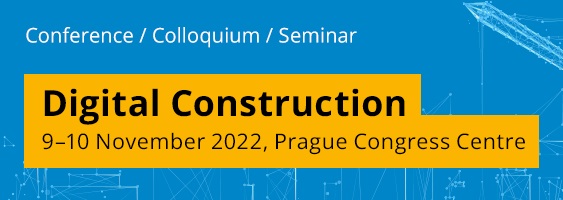
On November 9th and 10th, the president of IBIMI-buildingSMART Prague participated in the "Digital Construction conference” organized by the Czech Ministry of Industry and Trade in Prague, in collaboration with buildingSMART Czech Republic, with the goal to outline the possible development paths of the sector towards Construction 4.0 .
Many representatives of buildingSMART International and of the individual national chapters attended the conference, confirming the importance of the role played by our community in the digital transformation of the building supply chain.
The construction industry is still the least digitized sector of all and, at the same time, one of the largest contributors to GDP in all European countries. Add to this the stagnant levels of labor productivity and the urgency of undertaking profound changes becomes evident.
The main purpose of this meeting was to find new solutions to stimulate the flow of data in the sector and accelerate construction processes through Building Information Modeling (BIM) and improve the technological and data ecosystem of the construction industry.
No less important, the other topics discussed included the introduction of digital transition and BIM in the public sector, the revolution in the acceleration of building permit processing, robotization, automation and prefabrication in the construction ecosystem.



The good news is that much-needed change is already underway. After decades of under-digitalization, the construction sector seems ready to start a new era. New analyzes of the construction technology ecosystem uncover emerging trends, solutions, and a growing universe of technology use cases that are revolutionizing the way we plan, design, and execute construction projects.
The development of robotics and 3D printers will be solutions not only to the lack of workforce in the construction industry but also to problems related to the safety of workers. For instance, for the reconstruction interventions in risk areas, a "hot" topic also supported by the CECE (Committee for European Construction Equipment https://cece.eu/) in relation to the recent events in Ukraine.
The discussion with Katharina Knapton-Vierlich, the new representative of DG Growth H1 construction, on "digital transition and BIM in the public sector", was very interesting. The goal is to identify a common digital development strategy between the Member States and the European Commission, which would support it with specific funding programmes. Topic of extreme relevance for buildingSMART. For this reason, the dialogue started in Prague will be deepened with the Commission during the buildingSMART summit to be held in Rome next March.

Extremely interesting was also the European Commission initiative on the Digital Building Logbook, with the goal of promoting transparency and greater availability of data for a wide range of market operators (property owners, tenants, investors, financial institutions and public administrations). The idea is to provide a guideline that catalogs and stores all the information deemed important for a Digital Building File in a format that synchronizes the methodologies used in the various member countries, also through R&I projects for the implementation of the Digital Register financed by the Commission.
At the end, it was also discussed the impact of this transformation on human resources, focusing in particular on training. The digitization of the supply chain must not be perceived as a threat by workers in the sector, but recognized as a way to improve the image and the working conditions in the industry. The right training courses and the right skills will in fact make the sector more attractive to younger workers. And it is precisely in this direction that buildingSMART International is going with the work at the tables of the Professional Certification Program (PCERT), the professional qualification program designed to provide a certificate compliant with local regulations and at the same time having international validity on skills in the BIM and openBIM.
Many of the points raised during the conference in Prague will be the subject of further debate and study at the buildingSMART International Standards Summit in Rome. We invite you therefore to continue following us and to join us on the occasion of the Summit.
SAVE THE DATE: buildingSMART International Standards Summit - Auditorium della Tecnica, Rome – 27/30 March 2023
Giulia Riccardi
Anna Moreno
Caterina Nissim
BIM and sustainability in the construction industry
The use of BIM and the holistic approach to sustainability in the construction industry
Energy savings, consciousness about natural resources, reduction of pollution and respect for the environment. The theme of green development of cities is a challenge in which the construction sector has a central role to play.
Fortunately, design and technologies are moving on an increasingly “green” track: architects are always more motivated by the desire to create buildings that create dialogues between man and nature. The cities of the future are (very) slowly and gradually developing obligations to comply with environment-friendly practices and standards which, for the sake of simplicity, we will call "sustainability".
Construction is an energy-intensive sector with a high share of global pollution: it is in fact responsible for 36% of energy consumption and 39% of carbon dioxide emissions into the atmosphere. This is the reason the sector has a huge responsibility and the duty to initiate better practices and virtuous processes to reduce its impact on the planet as quickly as possible.
Augmenting the sustainability in construction is not an easy problem to tackle and there are not fast lanes bringing there. There is a large number of different tracks to consider and we can only speak about sustainability in construction following an holistic and exhaustive approach.
Too often, in construction, the scale to measure sustainability is confused and reduced to specific energy requirements. In fact, also due to a regulatory framework that has not yet been defined in Europe and sustainability assessment procedures and methods that have not yet been established, building projects are defined as sustainable only if it somehow leads to energy savings in a phase of the project's life same.
Sustainability must instead lie in the achievement of an optimal balance between the fulfillment, at different moments in time, of economic, environmental and social requirements, often in conflict with each other. All these different factors must be evaluated in a holistic and integrated way by the designer, as by all the different actors during the lifespan of the project.
Managing this large amount of information is not simple, but the BIM approach can constitute the right solution to optimize processes and achieve all the objectives on the environmental and energy front.
BIM is still often confused with a simple 3D model of the project or even with an architectural software. It consists instead in a real integrated design methodology involving all the professional figures engaged in the design, construction and maintenance of the project, contributing to the different aspects of the work.
BIM appears as a digital representation of the physical and functional characteristics of a building. It allows to share knowledge and the complete information about the property, supplying therefore a reliable basis for any decision necessary throughout the life cycle of the structure. BIM can deliver different views and aspects of the same information, such as 2D drawings, lists, texts, 3D images, animations, as well as elements of time (4D) and cost (5D).
This information is available during the entire project life cycle: mechanical and electrical layouts, design details, materials and so on in a 3D virtual space. In particular, by also including the concept of Life Cycle Assessment (LCA) analysis, the project team is able to fully assess the environmental impact.
Using the LCA analysis, all actors involved in the construction can evaluate the trend of the environmental impact from the first steps of the work such as the production of materials passing through the installation and implementation up to their disposal. The BIM also in relation to the LCA makes it possible to optimize the performance of the building as every aspect (plant engineering, lighting, energy, etc.) is evaluated in a more conscious way, allowing the work team to turn towards sustainable and lower-impact choices on the environment.
The potential of the BIM methodology in information management can therefore provide valid support for implementing LCA directly in the BIM environment with the aim of simplifying the evaluation procedures and the understanding and use of the results. Furthermore, BIM represents for many construction companies and design companies a valid decision making tool in terms of costs, times and design solutions and by extending this opportunity also to LCA assessments, it can be used profitably as a tool for assessing environmental sustainability of civil works.
To conclude, the use of BIM in the construction industry will not save the planet. However, the impact of the construction industry is a particularly heavy one on the environment, with much room for improvement and a variety of solutions to consider, from new technologies to collaborative approaches. It is the moral duty of each of us to take the necessary steps to move forward a more sustainable future.
The role of ARISE in the implementation of the new RES directive
Anna Moreno, Caterina Nissim
The proposal for a new directive on the promotion of renewable energy sources
The DIRECTIVE OF THE EUROPEAN PARLIAMENT AND OF THE COUNCIL amending Directives (EU) 2018/2001 and 98/70/EC, and the Regulation (EU) 2018/1999 as regards the promotion of energy from renewable sources is a proposal presented in July 2021. Some of the amendments are related to the national system for the qualification system of designers and installers of Renewable Energy Sources (RES) and they are therefore relevant for the ARISE partners.
Let’s examine these modifications in more detail.
Addressing the shortage of competent installers
This proposed modification intends to provide more experts in the domain of designers and installers of RES technologies but also to give the opportunity to other innovative technologies to be promoted thanks to the support of proper qualifications and certification systems. Below, In italic, the original text:
Article 1(7) amends Article 18(3) REDII with adjusted paragraphs on the qualification and certification requirements of installers to deal with the fact that there is a shortage of installers of renewable heating systems, which is a ‘brake’ on phasing out fossil fuel systems. It also deletes the list of specific types of renewable heating technologies and replaces it by a generic reference to RES heating systems.
This proposition opens the market to innovative solutions. ARISE's objective is to deliver a common platform where the competences about the new technologies are based on knowledge, skills and the degree of autonomy following the European Qualification Framework (EQF). For example, the producer of a new technology will be able to provide both the list of the new competences needed to design and install the new system and provide the body of knowledge for training workers and designers. This way, the developers of the new technology will be able to upload to the platform the body of knowledge required to design and/or develop training materials on the correct use of the new technology.
Making a public list of installers a requirement in each Member State
The new directive makes the creation of a public register a requirement:
It amends Article 18(4) REDII by obliging Member States to put in place measures to support participation in training programmes. The previous possibility for Member States to make the list of qualified installers public becomes a requirement.
In the deliverable 2.4, to be published soon on the ARISE web site, we mention the heterogeneity of the Member States on the issue. In countries such as Ireland and the Netherlands, public registers are already required and managed by a national organism while other countries, Portugal and Italy to mention a couple, are still far from the target. In Italy, the qualifications for the installers are realised at regional level, making the development of a national register extremely complex. ARISE will present a solution on a European scale, as the certification of the single competences would provide the tools to develop a singular national/European register. For each technology, it will be identified a list of compulsory competences at European level and each country/region will be able to identify the designers and workers who own those competences.
Requiring transparency in certification schemes issued by Member States for a mutual recognition
In Article 18, paragraphs 3 and 4 are replaced by the following:
- Member States shall ensure that certification schemes are available for installers and designers of all forms of renewable heating and cooling systems in buildings, industry and agriculture, and for installers of solar photovoltaic systems. Those schemes may take into account existing schemes and structures as appropriate, and shall be based on the criteria laid down in Annex IV. Each Member State shall recognise the certification awarded by other Member States in accordance with those criteria.
The ARISE platform will provide the tools for mutual recognition. Each Member State will identify its need in competences for each specific technology by referring to the ARISE platform unit of competences. The need in competences are obviously different in each country, depending on the climate, national regulations and so on. Thanks to an adaptation of these needed competences in each different country on the ARISE platform, it will be possible for workers to move and relocate in different countries all over Europe.
Increasing the number of qualified installers covering renewable heating and cooling technologies
Member States shall ensure that trained and qualified installers of renewable heating and cooling systems are available in sufficient numbers for the relevant technologies to service the growth of renewable heating and cooling required to contribute to the annual increase in the share of renewable energy in the heating and cooling sector as set out in Article 23.
To achieve such sufficient numbers of installers and designers, Member States shall ensure that sufficient training programmes leading to qualification or certification covering renewable heating and cooling technologies, and their latest innovative solutions, are made available. Member States shall put in place measures to promote participation in such programmes, in particular by small and medium-sized enterprises and the self-employed. Member States may put in place voluntary agreements with the relevant technology providers and vendors to train sufficient numbers of installers, which may be based on estimates of sales, in the latest innovative solutions and technologies available on the market.
ARISE has conceived an “open platform” guaranteeing the opportunity, for any professional and worker, to reach the desired “maturity level” for any technology necessary for their work as self-employed or employee. The ARISE platform is also open to producers who wish to ensure that designers and installers own the right competences to design and install their technology correctly.
Public lists of qualified/certified installers
- Member States shall make information on the certification schemes referred to in paragraph 3 available to the public. Member States shall ensure that the list of installers who are qualified or certified in accordance with paragraph 3 is regularly updated and made available to the public.
ARISE will provide a system to certify the single competence through blockchain technology. This means that each competence acquired will be certified and it will not be possible to “manipulate” it. The union of all competences required by each Member State to perform a specific activity, will be identified in the same ARISE platform so that workers will know what the gaps consist in.
Accreditation of the training programs
- The accreditation of the training programme or provider shall be affected by Member States or by the administrative body that they appoint. The accrediting body shall ensure that the training programme offered by the training provider has continuity and regional or national coverage.
The training provider shall have adequate technical facilities to provide practical training, including sufficient laboratory equipment or corresponding facilities to provide practical training.
The training provider shall offer, in addition to the basic training, shorter refresher and upskilling courses organised in training modules allowing installers and designers to add new competences, widen and diversify their skills across several technologies and their combinations. The training provider shall ensure adaptation of training to new renewable technologies in the context of buildings, industry and agriculture. Training providers shall recognise acquired relevant skills.
The training programmes and modules shall be designed to enable life-long learning in renewable installations and be compatible with vocational training for first time job seekers and adults seeking reskilling or new employment.
The training programmes shall be designed in order to facilitate acquiring qualification in different technologies and solutions and avoid limited specialisation in a specific brand or technology. The training provider may be the manufacturer of the equipment or system, institutes or associations.
The ARISE partners do not intend to organize trainings themselves, but to support training institutions by providing the tools to train and qualify blue and white collars for each technology. The platform will be the hinge between two worlds: the technologies producers and the workforce. Training providers will be able to propose the right qualifications selecting the competences in the ARISE platform and accessing to the right training materials. A minor percentage of the fee charged for the courses will be directed to the ARISE platform managers to ensure a regular update of contents. The training providers will manage the access to the trainees who wish to certify their competences with blockchain through the platform.
ARISE’s ultimate goal is to revolutionise the learning process by changing both delivery and recognition of sustainable energy skills in the construction sector. The new system of training and recognition of skills will be valid across the EU, thus increasing the spread of skilled workforce in the building market. The ARISE platform will be the tool to facilitate the duty of any stakeholder of the building chain (owners, producer, training institutions, workers, designers, regional and national qualification organizations) and will substantially contribute to the mobility of workers and services in the building industry through all Europe and beyond.
Anybody interested in contributing to the testing of the platform, please contact us and join our Forum on LinkedIn to participate to open debates.
The Italian Strategy for the qualification of BIM Professional Roles
Over the course of the last few years, IBIMI has developed the so-called Italian OpenBIM roadmap. It is like a path in which to grow and consolidate as an association on a Italian national scale and to be able to give BIM professionals the opportunity to be certified internationally according to the certification programme of buildingSMART International, an international body that oversees the development of open standards such as the IFC format. Common language and shared process are the founding bases that BIM professionals involved in the management of information throughout the building or civil supply chain (survey, design, construction, use, decommissioning) must possess.
On this assumption IBIMI is at the forefront of the development of certifications for figures such as BIM Specialist, Coordinator and Manager. These certifications will cover one of the first important milestones of the buildingSMART certification programme together with the, already widespread in Italy, Individual Qualification on the foundations of BIM methodology.
The association aims to make these certifications and related courses, available by training providers, by the end of this year or by the beginning of next year. The vision is to be able to develop certifications for other types of BIM professionals in the coming years, such as the CDE Manager, site operator, and so on.
On this page you will find the link to download the full document "THE ITALIAN STRATEGY FOR THE QUALIFICATION OF BIM PROFESSIONAL ROLES": https://www.ibimi.it/download/
Digitalisation: what is changing for architects?
An interview with Veronika Schröpfer, Head of EU Research Projects at the Architects’ Council of Europe
>> Digitalisation is changing the work of architects around the globe. At the moment there are around 560.000 architect in Europe, most of these working alone or in small offices. SMEs have the advantage to be quicker to adapt to new technologies and tools. Architects have shown themselves to be extremely willing to learn, more than half of those using each tool are self-taught. Architects are much more likely to use new tools out of personal or business interest than due to client or regulatory requirements. This shows that architects are enthusiastic to adopt digitalisation tools.
The role of the development of digital competences in the building domain
>> Architects contribute around 17 billion Euros to the EU economy (ACE, sector study 2020). Nevertheless, ACE has advocated for more diversity in software and tool providers. Annual licence fees for software can be a barrier for micro sized architecture practices. They cannot afford various licences for similar tools but different providers depending on the project. Hence the interoperability of tools and platforms are vital.
>> You can see in our 2020 ACE sector study, that there has been a proliferation of new digital tools which the architectural profession is adopting. A majority of architects use 3D modelling tools ‘frequently’, and nearly half use rendering tools frequently. About one in three architects frequently use BIM on their projects. An important aspect is that most architects use the tools out of their own choice.
The impact of putting in place a recognition system valid at European level
>> Our 2020 ACE Sector Study has revealed that the vast majority of architects taught themselves how to use digital tools.
No more than 35 per cent received formal training for any of the tools, although more received informal training. On average architects spend about 20 hours of official Continuing Professional Development (CPD) per year. CPD is a structured way of maintaining and developing the competence as a qualified professional by engaging in regular learning activities. For a training recognised and valid at EU level it should be endorsed by ACE Member Organisations in various EU Member States and meet the minimum agreed European quality standards. Various European training bodies should recognise each other’s CPD, making it easier for architects to work in the countries they choose. Usually, one learning hour equals one international CPD credit. Therefore, we joined the ARISE project, as it will work on the recognition of the CPD competences through the development of a platform based on microunits certified with blockchain.
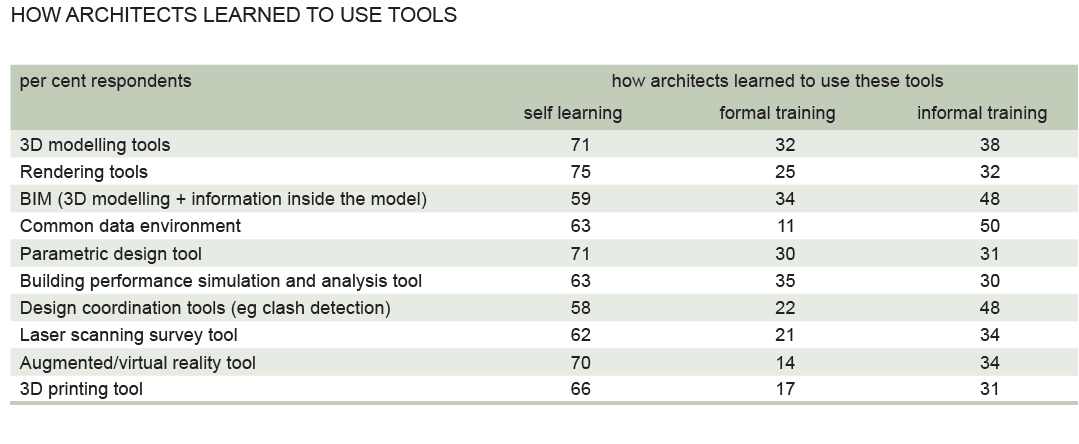
Dr. Veronika Schröpfer, Head of EU Research Projects at the Architects’ Council of Europe
Images and sources of numbers from the ACE Sector Study: https://www.ace-cae.eu/fileadmin/user_upload/2020ACESECTORSTUDY.pdf
Desk research on maturity analysis of digitalisation and sustainable energy skills
The ARISE team is carrying out Desk research on maturity analysis of digitalisation and sustainable energy skills.
The research is led by IECE on models of digital and energy skills frameworks and maturity levels, and developed by several H2020 and Erasmus+ funded projects and international brands (bSI).
The comparative study will include multi-criteria evaluation of skills and qualifications frameworks, identifying the level of compliance and complementarity and specifying similarities and differences thereof, as a specific proof of the ARISE concept of international transact-ability of learning achievements and competencies. One of the study outputs will be a novel model of levelling and alignment matrix developed by the learning outcomes based methodological approach and tested within the team, on several selected professional profiles. In further steps, it will be aligned with the UNESCO and CEDEFOP methodology (2017) by considering NQF as a reference point, and suggested as a sectoral methodology of comparison, alignment and transfer of qualifications.
The report will be published in early Spring 2022.
Access the link below for more information:
https://www.ariseproject.eu/reports/
New Guideline on the use of BIM for energy performance
The current global warming trend is greater than the 1.5 degrees value established during the Paris climate change summit. World leaders reiterated the need to halve emissions over the next decade and reach net zero carbon emissions by mid-century to limit global temperature rise to 1.5 degrees.
The result of this policy is leading to the construction of new buildings with very high performance, but there is a strong need to improve the energy performance of the existing building stock.
Integrating BIM into national climate-change and energy policies is necessary and challenging, as many of these buildings lack reliable information, which BIM can help generate, exchange and, most importantly, archive so that they can be used in the future regardless of the software that generated them. The use of open standards is therefore not an option but an obligation.
The working group on energy efficiency active within IBIMI (Institute for BIM Italy), the Italian chapter of buildingSMART International, worked on the drafting of guidelines on how BIM can contribute to improving energy performance in each phase of the life cycle of a building
The guidelines can be downloaded free of charge from the websitewww.buildingsmartitalia.organd will be used as Body of Knowledge for buildingSMART International Qualification Program on Energy Performance.
We would be grateful if you take a few minutes to answer to a survey on the use of BIM to improve the energy performance of buildings. This will help us to draw the roadmap on the competences needs. At this link the survey:https://docs.google.com/forms/d/e/1FAIpQLScaXQ5eD_FI7AUcs0_C0v3DcdgH5_XDSNMZbVS2vEoju_ixZg/viewform

